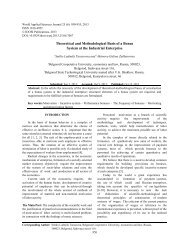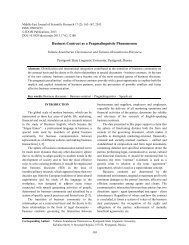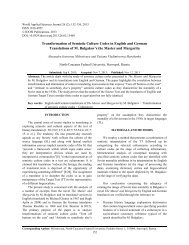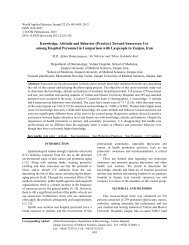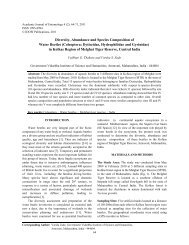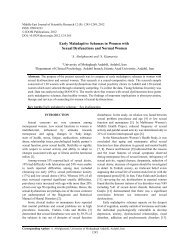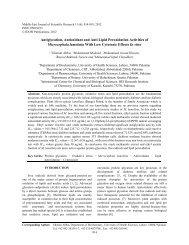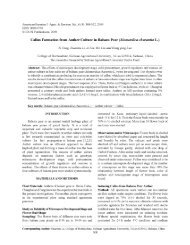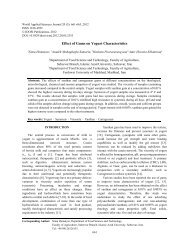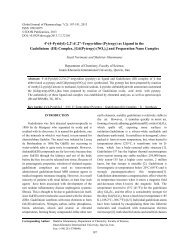Full Text - Idosi.org
Full Text - Idosi.org
Full Text - Idosi.org
Create successful ePaper yourself
Turn your PDF publications into a flip-book with our unique Google optimized e-Paper software.
Middle-East J. Sci. Res., 15 (7): 1059-1066, 2013<br />
him, only he can adequately assess the significance for fragments or pieces of images and sound, etc. According<br />
use in research practice of art and this proves that the to the author, the purpose of verification of source - the<br />
creator of the graphic source is, above all, a man with the establishment of full compliance with the original and the<br />
necessary technical and creative skills. As for addressing copy.<br />
the reliability of determining the source of the fine, they I would like to draw your attention to an article V.<br />
have resolved in the context of a real relationship to the Magidova, which addresses the most pressing issues<br />
world of the creator of the work and in the logic of public related to the place and role of audiovisual documents in<br />
perception of artistic works [32].<br />
the historical knowledge [35]. These problems are<br />
In the view of researchers in this period is another primarily associated with the underestimation of<br />
problem with methodological character when evaluating historians information potential of audiovisual sources<br />
audiovisual documents as historical sources. We have (entering it in the mental sphere of the historian), lack of<br />
already noted the controversial nature of the definition information on the composition of the historians and the<br />
(definitions) of audiovisual documents. Interest in these content of audiovisual fund of the country, the absence<br />
issues has generated the formation of new documentary of comprehensive information and heuristic of the<br />
systems, the occurrence and distribution of which is archives, the study of source historiographic heritage,<br />
associated with the development of science and active implementation and use of content analysis in the<br />
technology. This has led to the introduction of scientific evaluation of audiovisual sources, etc. It seems that these<br />
use of the term "technotronic documents" in relation to aspects of audiovisual documents acute and before<br />
science and technology, audio-visual, economic and Kazakh historical community. To date, the Kazakh<br />
electronic documents. Because they have a natural historical space potential source study audiovisual<br />
language as a system of signs is not completely sources remains unrealized. The exceptions are a few<br />
decisive role, some researchers had been formulated works of applied nature, which deals with information and<br />
yet another aspect of the treatment of the term educational opportunities for visual and audio sources<br />
"technotronic documents - documents, in whole or in that are stored in the Republican Central State Archive of<br />
part by artificial language technically induced forms Film and Photo Documents and sound recordings [36].<br />
of writing" [33]. The ambiguity of the term "fine source" The possibility and the need to study audiovisual sources<br />
notes the aforementioned author G. Lansky who sees as full of historical sources along with traditional written<br />
the fine specificity of the source, not only in their certificates remain in historical perspective.<br />
ability to communicate information about the phenomena<br />
of social history and the history of the spiritual culture,<br />
REFERENCES<br />
but also that they belong to one of the results of art, of<br />
fiction. 1. Magidov, V.M., 1984. A visible memory of history.<br />
In determining the validity and authenticity of Cit. in the book. pp: 13.<br />
historical sources as a condition for source analysis, some 2. Roshal, L.M., 2002. Beginning of all beginnings. The<br />
authors considered a fairly common as falsification of fact on the screen and cinema thought of "Silver age.<br />
facts and events recorded in audiovisual documents [34]. pp: 37-45.<br />
Thus, VP Goats in his extensive article dwells on the laws 3. Wolves Lannit, L.F., 1980. History is written by the<br />
of creation, existence and exposing fraud historical lens., pp: 44.<br />
sources. They identified the peculiar formula falsification 4. Altshuler, B.A., 1987. Educational cinema:<br />
of historical sources and typology of fraud related to the Development stages: Studies. grants, pp: 12.<br />
phenomenon of counterfeiting. Another researcher, 5. Grekov, B.D., 1939. History and Film. Soviet historical<br />
V.M.Magidov points most often found ways of rigging film. p.p:9-13; 6.Rudelson K.I. 1973. Modern<br />
audiovisual sources, the establishment of which is a Document Classifications, pp: 67.<br />
guarantee of correctness historical conclusions. 7. Chernomorski, M.N., 1966. Chronology History of the<br />
Among them are highlighted: the assembly of the various USSR (Soviet era), pp: 48.<br />
surveys and records, retouching, through which part of 8. Autocratov, V.N., 2001. Theoretical Problems of<br />
the image is replaced by another one, increases or Domestic Archival, pp: 139.<br />
decreases the effect of a necessary element of the iconic 9. Nikiforov, E.I., 1968. On the critical analysis of<br />
shooting, etc., the use of documentaries, TV and radio film material and their place in the State Archives,<br />
dramatizations of real events, the removal of individual pp: 84-95.<br />
1065



